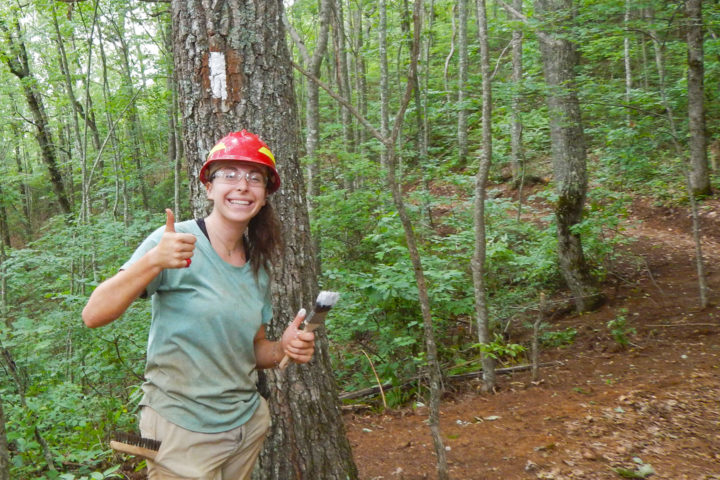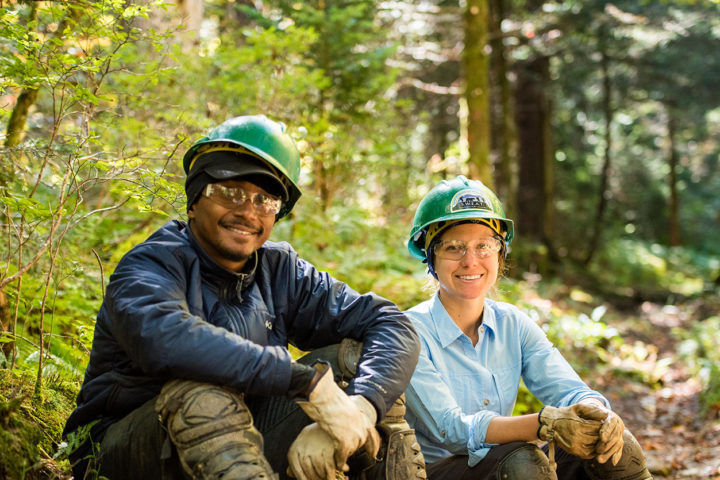by Jessie Johnson, ATC Volunteer Engagement Specialist
Leveraging the Power of Groups
The benefits of partnering with groups on volunteer projects can extend far beyond the positive impacts on the Trail. These collaborations provide an ideal setting for sharing your club’s mission, successes, and needs. They also provide an opportunity for long-term relationships with the group and/or interested individuals.

Collaborating with groups on volunteer projects can help A.T. Clubs:
- Significantly extend their reach by building awareness of its mission among more area residents and community members.
- Leverage the social capital of group members by helping them build fondness for the A.T.
- Attract a more varied pool of volunteers.
While the work of collaborating with groups requires flexibility and advanced coordination, these partnerships also serve as the catalyst for mutually beneficial ongoing relationships.
Internal Assessment
Because each club and group has unique needs, there is no “one size fits all” approach to working with groups. Performing a basic internal assessment of your club’s ability to coordinate with groups can make it easier to take advantage of the benefits of group volunteer projects. To prepare for group requests:
- Identify club members who are willing to manage communication with groups.
- Determine who can lead group volunteer projects.
- Create a list of group-friendly projects appropriate for a range of group sizes and ages, skill sets, time commitments, and locations.
- Decide who will take responsibility for post-event engagement, including thanking the group, sharing photos and successes, and inviting group members to join future volunteer events.
Planning
As groups connect with your organization, it is important to assess their expectations against the pre-planning your organization has undertaken about needs. To determine the best ways to apply their interest to help the Appalachian Trail, have a pre-planning conversation to assess the group’s goals, needs, and experience. Ask the group for the following information:
- Experience: What do leaders and/or participants hope to gain? Understanding if the group seeks to build team dynamics, gain service-work hours, understand the science of trail work or seek some other kind of educational component, can help the leaders to provide a positive experience that builds affinity for the club and A.T. volunteerism.
- Group Size and Age Range: How many people are part of the group and how many are interested in volunteering? Does the group include children or teenagers?
- Group Goals: What does the group hope to accomplish through volunteering? What was the motivation to volunteer on the Appalachian Trail?
- Activity: What is the general activity level of the group members? Is the group best suited for light, medium, or heavy-duty work? Has anyone volunteered on the Appalachian Trail or other trails?
- Timing: Does the group have specific dates or times in mind? Is the goal a one-time event or an ongoing project? What is the ideal duration of the volunteer experience (half day, full day, a few consecutive days, etc.)?
- Travel Distance: How far can the group travel to volunteer?
- Timeframe: Be realistic with groups about the time needed to plan and execute a successful volunteer event. Ideally, these activities are planned at least three to six months in advance.
Additionally, it is important to consider the bandwidth of your club’s staff and/or volunteers and recognize when a group’s needs and goals are not a good fit. However, when possible, consider ways that your club and the group can be flexible in planning a mutually beneficial volunteer project. Consider how working with a group can help meet your club’s goals, such as trail maintenance, increased awareness of your club in the community, attracting more varied volunteers, or publicity opportunities.

Continued Engagement
Working with groups provides an opportunity for your A.T. club to organically share its unique story with participants from the group.
- Take advantage of pre-trip communication and on-site briefings and conversations to share your club’s story and how the group’s volunteer work benefits Trail users, the local environment, and/or the community.
- Recognize opportunities for shared storytelling through your club’s and the partner group’s social media accounts that can amplify messages and connections that expand beyond the reach of the project and the A.T. Club.
- After the event, follow up with the group. It’s ideal to connect with individual group members so that if there is turnover in the group’s leadership, you can continue to connect with interested participants. Share accomplishments and photos and include a call to action by inviting them to join your club and share future volunteer opportunities.

Partnering with existing groups provides your club a valuable opportunity to expand your reach, engage varied volunteers, and build lasting relationships. By being flexible, thoughtful, and strategic in these collaborations, your club can significantly enhance its impact on the Appalachian Trail while fostering a broader community of volunteers dedicated to advancing stewardship efforts.
Discover More

From maintenance of the footpath and its facilities to greeting guests
Volunteer Opportunities
The Appalachian Trail (A.T.) would not exist without volunteers.

Read More
First-Time Volunteer Stories
Volunteers share their experiences maintaining the Appalachian Trail (A.T.) and its boundary for the first time.

ATC's Volunteer Blog and Newsletter
The Register
Learn more about A.T. volunteerism and the stewards who keep the dream of the Trail alive.
